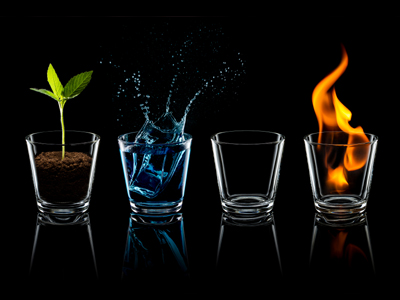
Ask the AI Tutor
Need help with Chemistry - Elements and Compounds (AQA)? Ask our AI Tutor!
AI Tutor - Lucy
Connecting with Tutor...
Please wait while we establish connection

Scientists once believed that there were only four elements - earth, water, air and fire.
Chemistry - Elements and Compounds (AQA)
Elements and compounds build the chemical world around you. Learn how simple substances join together to form new materials with very different properties.
1 .
All elements and compounds are made from what?
Atoms
Molecules
Ions
Varying quantities of fire, earth, air and water
Molecules are made by joining atoms together
2 .
Which of the following is the correct definition of a compound?
A substance containing atoms of one element
A substance containing atoms of two elements
A substance containing atoms of two elements chemically bonded
A substance containing atoms of two or more elements chemically bonded
The first answer is completely wrong - it describes and element.
The second and third answers are only partly correct - they don't go far enough
The second and third answers are only partly correct - they don't go far enough
3 .
Which of the following lists contains only metallic elements?
Al, CO, Fe, Mg, Au
Na, Li, I, Zn, Fe
Fe, Al, Na, Mg, Zn
Cu, Pt, Fe, Ag, Br
The first answer is designed to test if you recognise that the symbol for an element has only one capital letter. CO is a compound of carbon and oxygen, some of you may have thought it was the metal, cobalt (symbol Co)
4 .
Which of the following lists contains the missing words from the following passage in the right order?
There are over a __________ different types of atom, called __________. The atoms of a particular element are ___________ to each other. They cannot be changed ____________ into any different element. _________ are substances that contain atoms of at least two elements chemically combined.
There are over a __________ different types of atom, called __________. The atoms of a particular element are ___________ to each other. They cannot be changed ____________ into any different element. _________ are substances that contain atoms of at least two elements chemically combined.
hundred, elements, identical, chemically, compounds
lot, hundred, compounds, elements, joined
hundred, compounds, identical, chemically, elements
elements, hundred, compound, same, joined, ions
Make sure that you know and understand the differences between elements and compounds for the exam. One way or another, your knowledge of these basic concepts will be tested
5 .
Which of the following best describes the atoms of an element?
The atoms of an element are round
The atoms of an element are the same colour
The atoms of an element are the same type
The atoms of an element are solid
This is one of the basic definitions in chemistry
6 .
Elements normally exist as atoms but they can form charged particles called ions. How do they do this?
It happens when the atoms are rubbed on a piece of fabric
They lose or gain at least one electron
It can only happen to them in a Van-der-Graaf machine
They are only formed in space where there are cosmic rays
This is what happens during ionic bonding between metals and non-metals
7 .
Which of the following is a compound containing non-metals only?
Sodium carbonate
Methane
Calcium chloride
Iron fluoride
Methane is a hydrocarbon and contains no metal atoms
8 .
Elements are listed on the periodic table and can be classified as metals and non-metals. Where are they found on the periodic table?
Metals on the right, non-metals on the left
Metals on the left, non-metals on the right
They are not arranged in any particular order
The non-metals are at the centre with metals around the outside
The elements on the left of the dividing line between metals and non-metals are called metalloids (sometimes they are referred to as semi-metals)
9 .
In chemical equations the atoms of each element are represented by what?
Numbers
Colours
Shapes
Symbols
A chemical symbol always begins with a capital letter. Co (cobalt) is VERY different to CO (carbon monoxide)
10 .
When atoms join together to form molecules what happens to their electrons?
A pair of electrons is transferred from one atom to the other
The atoms lose at least one pair of electrons
The atoms gain at least one pair of electrons
The atoms share at least one pair of electrons
This is covalent bonding and it occurs only when non-metallic elements combine
**Unlimited Quizzes Await You! 🚀**
Hey there, quiz champ! 🌟 You've already tackled today's free questions.
Ready for more?
Ready for more?
🔓 Unlock UNLIMITED Quizzes and challenge yourself every day. But that's
not all...
not all...
🔥 As a Subscriber you can join our thrilling "Daily Streak" against other
quizzers. Try to win a coveted spot on our Hall of Fame Page.
quizzers. Try to win a coveted spot on our Hall of Fame Page.
Don't miss out! Join us now and keep the fun rolling. 🎉
**Unlimited Quizzes Await You! 🚀**
Hey there, quiz champ! 🌟 You've already tackled today's free questions. Ready for more?
🔓 Unlock UNLIMITED Quizzes and challenge yourself every day. But that's not all...
🔥 As a Subscriber you can join our thrilling "Daily Streak" against other quizzers. Try to win a coveted spot on our Hall of Fame Page.
Don't miss out! Join us now and keep the fun rolling. 🎉






